technical specifications FORD F650/750 2023 Owners Manual
[x] Cancel search | Manufacturer: FORD, Model Year: 2023, Model line: F650/750, Model: FORD F650/750 2023Pages: 378, PDF Size: 5.65 MB
Page 9 of 378
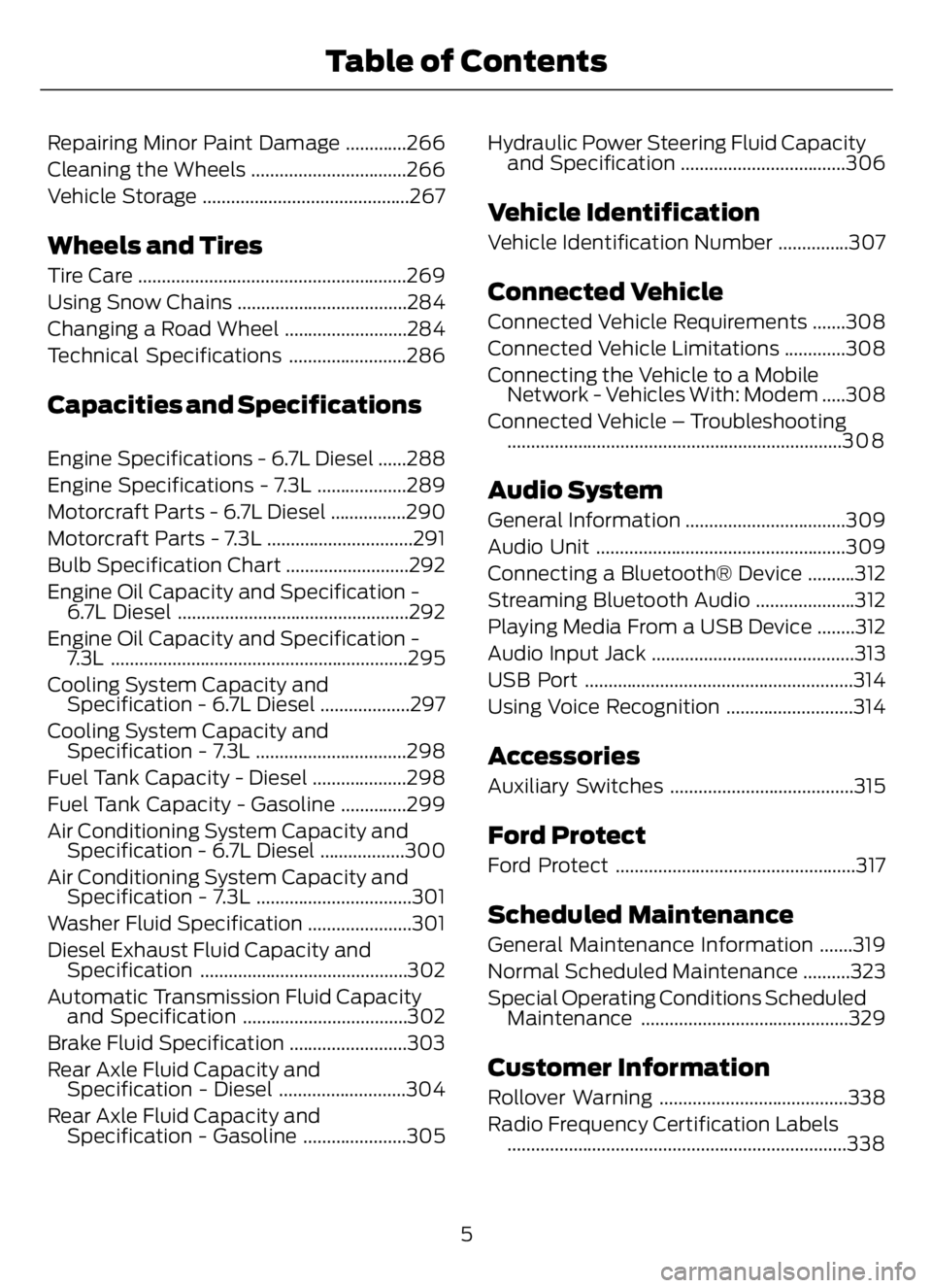
Repairing Minor Paint Damage .............266
Cleaning the Wheels .................................266
Vehicle Storage ............................................267
Wheels and Tires
Tire Care .........................................................269
Using Snow Chains ....................................284
Changing a Road Wheel ..........................284
Technical Specifications .........................286
Capacities and Specifications
Engine Specifications - 6.7L Diesel ......288
Engine Specifications - 7.3L ...................289
Motorcraft Parts - 6.7L Diesel ................290
Motorcraft Parts - 7.3L ...............................291
Bulb Specification Chart ..........................292
Engine Oil Capacity and Specification -
6.7L Diesel .................................................292
Engine Oil Capacity and Specification -
7.3L ...............................................................295
Cooling System Capacity and
Specification - 6.7L Diesel ...................297
Cooling System Capacity and
Specification - 7.3L ................................298
Fuel Tank Capacity - Diesel ....................298
Fuel Tank Capacity - Gasoline ..............299
Air Conditioning System Capacity and
Specification - 6.7L Diesel ..................300
Air Conditioning System Capacity and
Specification - 7.3L .................................301
Washer Fluid Specification ......................301
Diesel Exhaust Fluid Capacity and
Specification ............................................302
Automatic Transmission Fluid Capacity
and Specification ...................................302
Brake Fluid Specification .........................303
Rear Axle Fluid Capacity and
Specification - Diesel ...........................304
Rear Axle Fluid Capacity and
Specification - Gasoline ......................305Hydraulic Power Steering Fluid Capacity
and Specification ...................................306
Vehicle Identification
Vehicle Identification Number ...............307
Connected Vehicle
Connected Vehicle Requirements .......308
Connected Vehicle Limitations .............308
Connecting the Vehicle to a Mobile
Network - Vehicles With: Modem .....308
Connected Vehicle – Troubleshooting
.......................................................................3 0 8
Audio System
General Information ..................................309
Audio Unit .....................................................309
Connecting a Bluetooth® Device ..........312
Streaming Bluetooth Audio .....................312
Playing Media From a USB Device ........312
Audio Input Jack ...........................................313
USB Port .........................................................314
Using Voice Recognition ...........................314
Accessories
Auxiliary Switches .......................................315
Ford Protect
Ford Protect ...................................................317
Scheduled Maintenance
General Maintenance Information .......319
Normal Scheduled Maintenance ..........323
Special Operating Conditions Scheduled
Maintenance ............................................329
Customer Information
Rollover Warning ........................................338
Radio Frequency Certification Labels
........................................................................338
5
Table of Contents
Page 49 of 378

GENERAL INFORMATION ON
RADIO FREQUENCIES
This device complies with Part 15 of the
FCC Rules and with Industry Canada
license-exempt RSS standard(s).
Operation is subject to the following two
conditions: (1) This device may not cause
harmful interference, and (2) This device
must accept any interference received,
including interference that may cause
undesired operation.
WARNING: Changes or
modifications not expressively approved
by the party responsible for compliance
could void the user's authority to operate
the equipment. The term "IC:" before the
radio certification number only signifies
that Industry Canada technical
specifications were met.
The typical operating range for your
transmitter is approximately 33 ft (10 m).
Vehicles with the remote start feature will
have a greater range.
One of the following could cause a
decrease in operating range:
• Weather conditions.
• Nearby radio towers.
• Structures around the vehicle.
• Other vehicles parked next to your
vehicle.
The radio frequency used by your remote
control can also be used by other radio
transmitters, for example amateur radios,
medical equipment, wireless headphones,
wireless remote controls, cell phones,
battery chargers and alarm systems. If the
frequencies are jammed, you will not be
able to use your remote control. You can
lock and unlock the doors with the key.
Note:Make sure to lock your vehicle before
leaving it unattended.Note:If you are in range, the remote control
will operate if you press any button
unintentionally.
Note:The remote control contains sensitive
electrical components. Exposure to moisture
or impact may cause permanent damage.
Intelligent Access (If Equipped)
The system uses a radio frequency signal
to communicate with your vehicle and
authorize your vehicle to unlock when one
of the following conditions are met:
• You activate the front exterior door
handle switch.
• You press the luggage compartment
button.
• You press a button on the transmitter.
If excessive radio frequency interference
is present in the area or if the transmitter
battery is low, you may need to
mechanically unlock your door. You can
use the mechanical key blade in your
intelligent access key to open the driver
door in this situation. See Remote
Control (page 46).
45
Keys and Remote Controls
Page 289 of 378
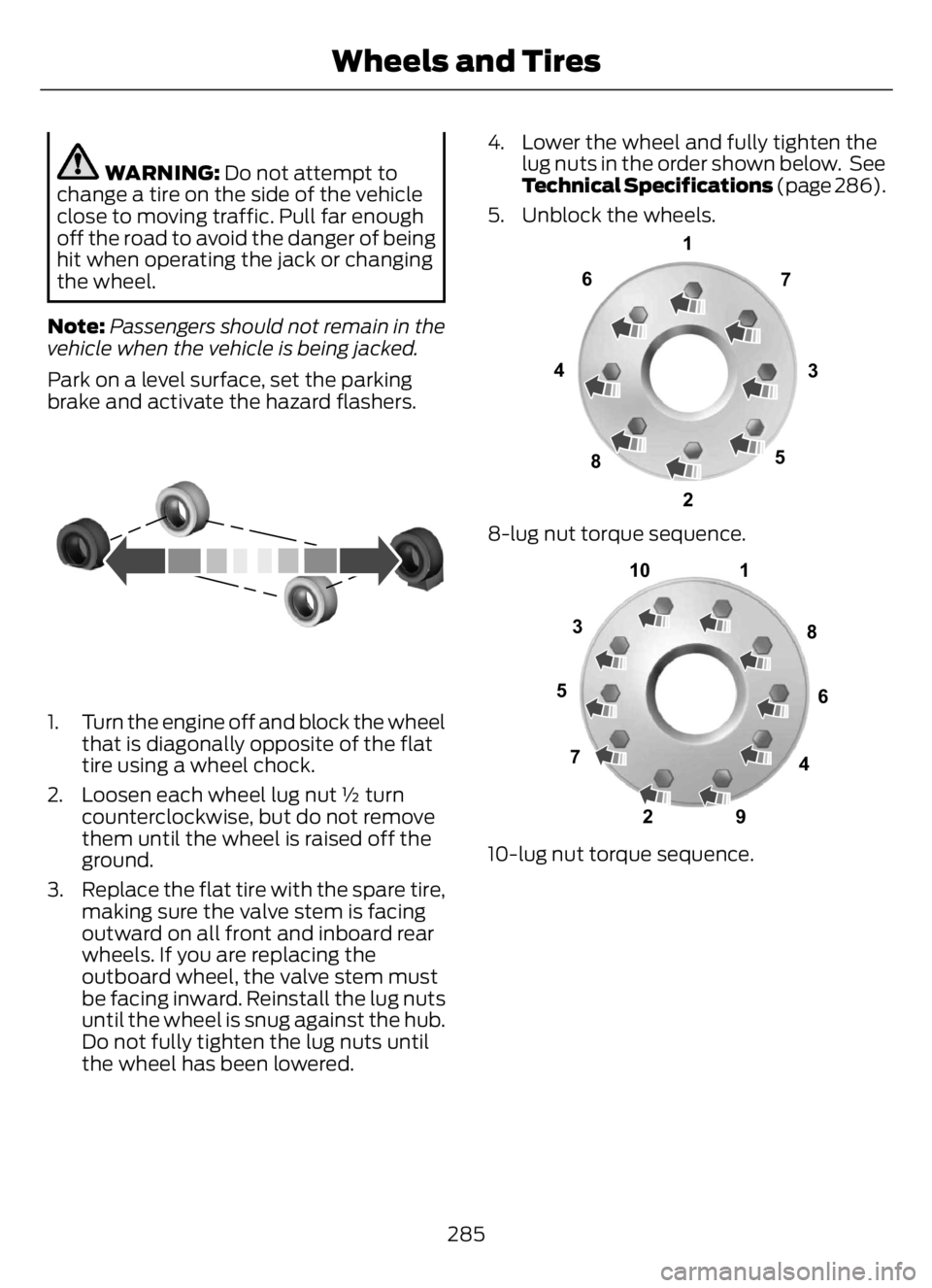
WARNING: Do not attempt to
change a tire on the side of the vehicle
close to moving traffic. Pull far enough
off the road to avoid the danger of being
hit when operating the jack or changing
the wheel.
Note:Passengers should not remain in the
vehicle when the vehicle is being jacked.
Park on a level surface, set the parking
brake and activate the hazard flashers.
1. Turn the engine off and block the wheel
that is diagonally opposite of the flat
tire using a wheel chock.
2. Loosen each wheel lug nut ½ turn
counterclockwise, but do not remove
them until the wheel is raised off the
ground.
3. Replace the flat tire with the spare tire,
making sure the valve stem is facing
outward on all front and inboard rear
wheels. If you are replacing the
outboard wheel, the valve stem must
be facing inward. Reinstall the lug nuts
until the wheel is snug against the hub.
Do not fully tighten the lug nuts until
the wheel has been lowered.4. Lower the wheel and fully tighten the
lug nuts in the order shown below. See
Technical Specifications (page 286).
5. Unblock the wheels.
E161441E161441
1
3 4
27 6
5
8
8-lug nut torque sequence.
1
2 3
4 5
6
78
9 10
E169375E169375
10-lug nut torque sequence.
285
Wheels and Tires
Page 290 of 378

TECHNICAL SPECIFICATIONS
Wheel Lug Nut Torque Specifications
WARNING: When you install a wheel, always remove any corrosion, dirt or foreign
materials present on the mounting surfaces of the wheel or the surface of the wheel
hub, brake drum or brake disc that contacts the wheel. Make sure to secure any fasteners
that attach the rotor to the hub so they do not interfere with the mounting surfaces of
the wheel. Installing wheels without correct metal-to-metal contact at the wheel
mounting surfaces can cause the wheel nuts to loosen and the wheel to come off while
your vehicle is in motion, resulting in loss of vehicle control, personal injury or death.
lb.ft (Nm)1Bolt size
450–500 lb.ft (610–678 Nm) M22 x 1.5
1 Torque specifications are for nut and bolt threads free of dirt and rust. Use only Ford
recommended replacement fasteners.
On vehicles equipped with single rear wheels, retighten the lug nuts to the specified torque
at 100 mi (160 km) after any wheel disturbance (such as tire rotation, changing a flat tire,
wheel removal).
On vehicles equipped with dual rear wheels, retighten the lug nuts to the specified torque
at 100 mi (160 km) and again at 500 mi (800 km) of new vehicle operation and after
any wheel disturbance (such as tire rotation, changing a flat tire, wheel removal).
It is important to follow the proper wheel mounting and lug nut torque procedures.
E161443
On all two-piece flat wheel nuts,
apply one drop of motor oil
between the flat washer and the
nut. Do not apply motor oil to the
wheel nut threads or the wheel
stud threads.
286
Wheels and Tires
Page 326 of 378

Check Every Month
Tires (including spare) for wear and proper pressure.
Windshield washer fluid level.
1Diesel engine only.
Check Every Six Months
Battery connections. Clean if necessary.
Body and door drain holes for obstructions. Clean if necessary.
Cooling system fluid level and coolant concentration (freeze-point protection).
Door weatherstrips for wear. Lubricate if necessary.
Hinges, latches and outside locks for proper operation. Lubricate if necessary.
Parking brake for proper operation.
Safety belts and seat latches for wear and function.
Safety warning lamps (brake, ABS, airbag and safety belt) for operation.
Washer spray and wiper operation. Clean or replace blades as necessary.
Tightening Lug Nuts
Tighten the lug nuts to the specified torque1 at 500 mi
(800 km) after any wheel disturbance (such as tire rota-
tion, changing a flat tire or wheel removal). Single rear wheels
Tighten the wheel lug nuts to the specified torque
1 at
100 mi (160 km), and again at 500 mi (800 km) of new
vehicle operation and after any wheel disturbance (such
as tire rotation, changing a flat tire or wheel removal). Dual rear wheels
1 See Technical Specifications (page 286).
322
Scheduled Maintenance
Page 345 of 378
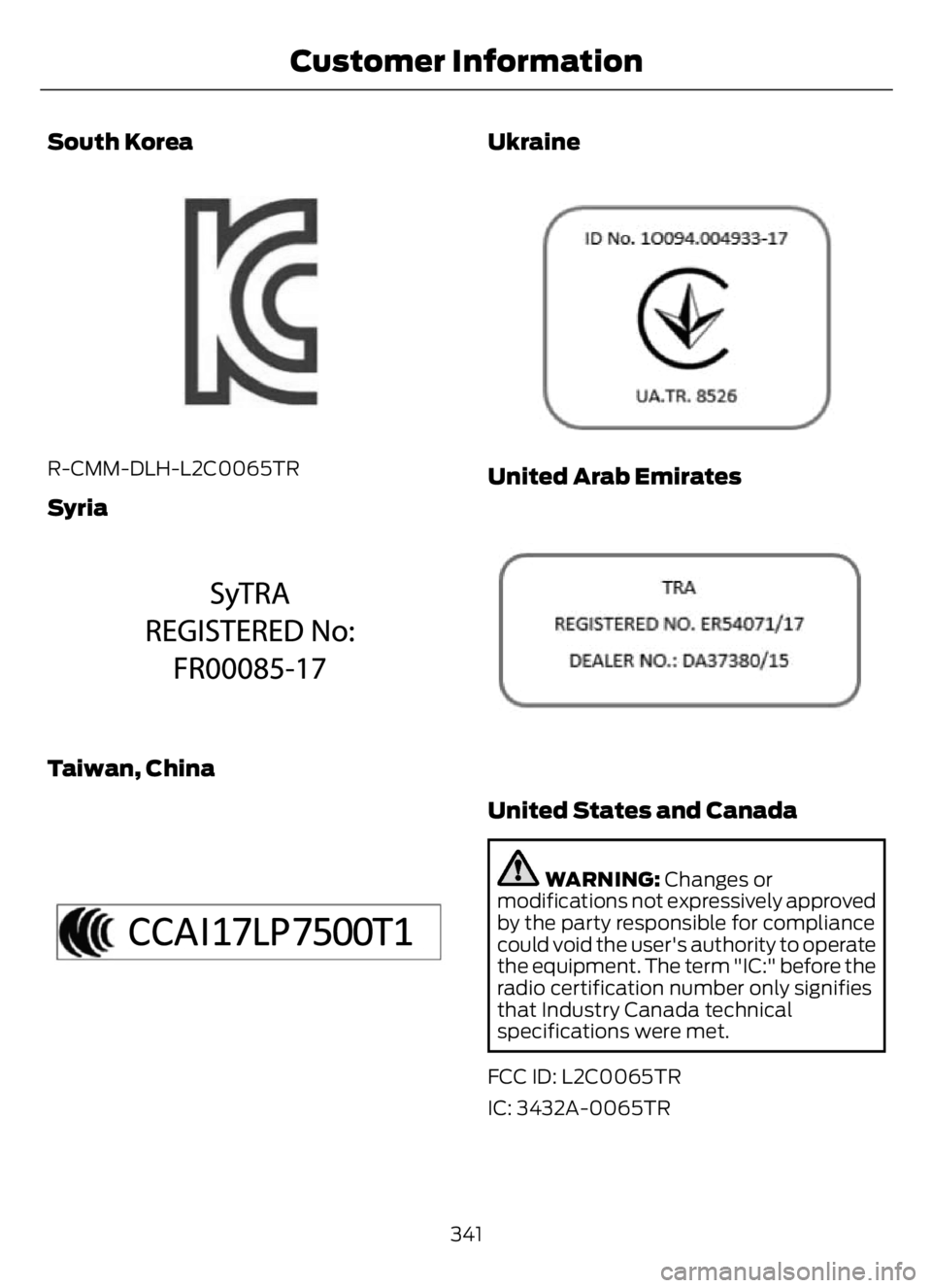
South Korea
E339675E339675
R-CMM-DLH-L2C0065TR
Syria
E342397E342397
Taiwan, China
E340195E340195
Ukraine
E3308043
United Arab Emirates
E308044044
United States and Canada
WARNING: Changes or
modifications not expressively approved
by the party responsible for compliance
could void the user's authority to operate
the equipment. The term "IC:" before the
radio certification number only signifies
that Industry Canada technical
specifications were met.
FCC ID: L2C0065TR
IC: 3432A-0065TR
341
Customer Information
Page 371 of 378
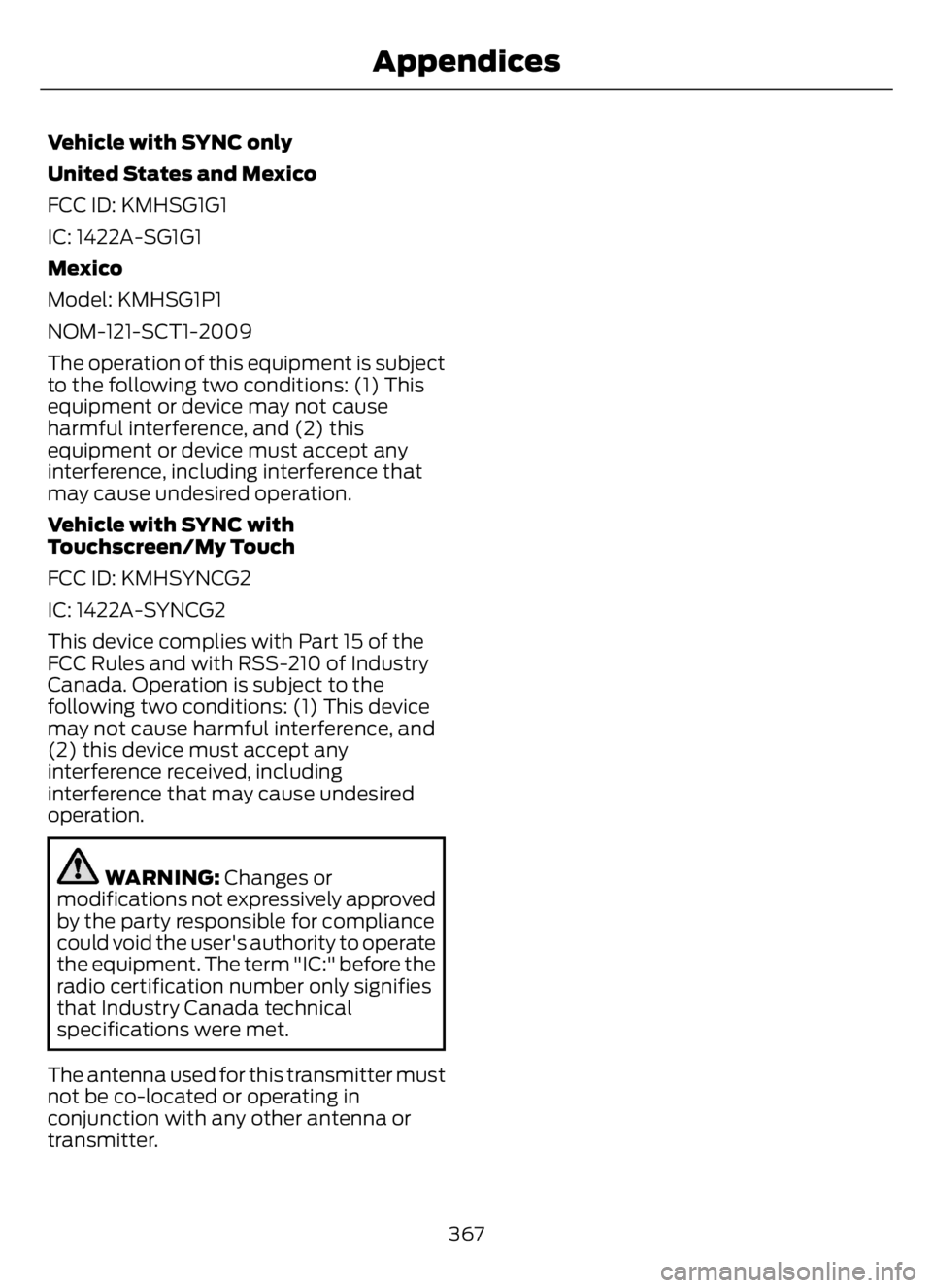
Vehicle with SYNC only
United States and Mexico
FCC ID: KMHSG1G1
IC: 1422A-SG1G1
Mexico
Model: KMHSG1P1
NOM-121-SCT1-2009
The operation of this equipment is subject
to the following two conditions: (1) This
equipment or device may not cause
harmful interference, and (2) this
equipment or device must accept any
interference, including interference that
may cause undesired operation.
Vehicle with SYNC with
Touchscreen/My Touch
FCC ID: KMHSYNCG2
IC: 1422A-SYNCG2
This device complies with Part 15 of the
FCC Rules and with RSS-210 of Industry
Canada. Operation is subject to the
following two conditions: (1) This device
may not cause harmful interference, and
(2) this device must accept any
interference received, including
interference that may cause undesired
operation.
WARNING: Changes or
modifications not expressively approved
by the party responsible for compliance
could void the user's authority to operate
the equipment. The term "IC:" before the
radio certification number only signifies
that Industry Canada technical
specifications were met.
The antenna used for this transmitter must
not be co-located or operating in
conjunction with any other antenna or
transmitter.
367
Appendices
Page 377 of 378
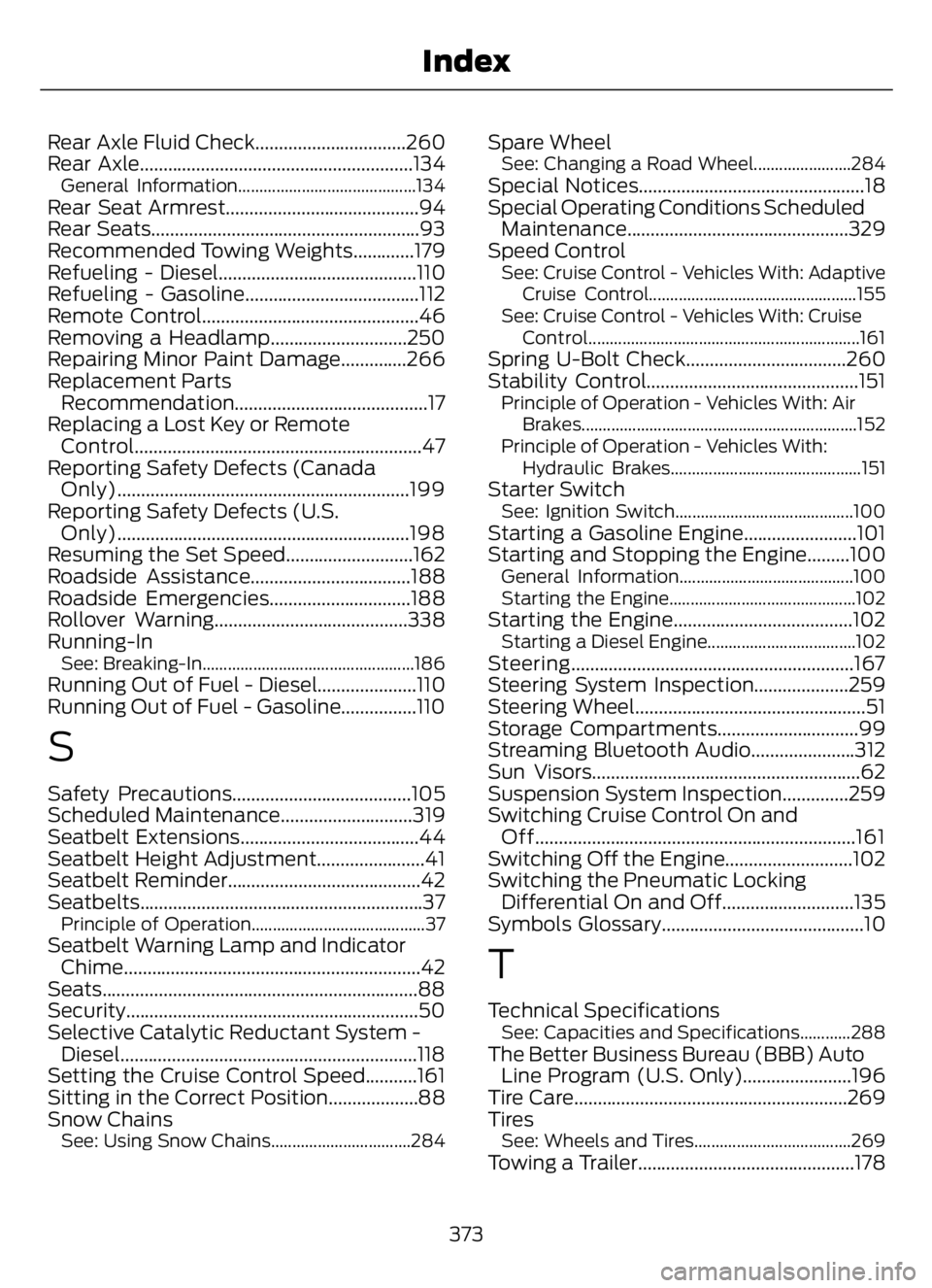
Rear Axle Fluid Check................................260
Rear Axle..........................................................134
General Information..........................................134Rear Seat Armrest.........................................94
Rear Seats.........................................................93
Recommended Towing Weights.............179
Refueling - Diesel..........................................110
Refueling - Gasoline.....................................112
Remote Control..............................................46
Removing a Headlamp.............................250
Repairing Minor Paint Damage..............266
Replacement Parts
Recommendation.........................................17
Replacing a Lost Key or Remote
Control.............................................................47
Reporting Safety Defects (Canada
Only)..............................................................199
Reporting Safety Defects (U.S.
Only)..............................................................198
Resuming the Set Speed...........................162
Roadside Assistance..................................188
Roadside Emergencies..............................188
Rollover Warning.........................................338
Running-In
See: Breaking-In..................................................186Running Out of Fuel - Diesel.....................110
Running Out of Fuel - Gasoline................110
S
Safety Precautions......................................105
Scheduled Maintenance............................319
Seatbelt Extensions......................................44
Seatbelt Height Adjustment.......................41
Seatbelt Reminder.........................................42
Seatbelts............................................................37
Principle of Operation.........................................37Seatbelt Warning Lamp and Indicator
Chime...............................................................42
Seats...................................................................88
Security..............................................................50
Selective Catalytic Reductant System -
Diesel...............................................................118
Setting the Cruise Control Speed...........161
Sitting in the Correct Position...................88
Snow Chains
See: Using Snow Chains.................................284
Spare WheelSee: Changing a Road Wheel.......................284Special Notices................................................18
Special Operating Conditions Scheduled
Maintenance...............................................329
Speed Control
See: Cruise Control - Vehicles With: Adaptive
Cruise Control.................................................155
See: Cruise Control - Vehicles With: Cruise
Control................................................................161
Spring U-Bolt Check..................................260
Stability Control.............................................151
Principle of Operation - Vehicles With: Air
Brakes.................................................................152
Principle of Operation - Vehicles With:
Hydraulic Brakes.............................................151
Starter SwitchSee: Ignition Switch..........................................100Starting a Gasoline Engine........................101
Starting and Stopping the Engine.........100
General Information.........................................100
Starting the Engine............................................102
Starting the Engine......................................102Starting a Diesel Engine...................................102Steering............................................................167
Steering System Inspection....................259
Steering Wheel.................................................51
Storage Compartments..............................99
Streaming Bluetooth Audio......................312
Sun Visors.........................................................62
Suspension System Inspection..............259
Switching Cruise Control On and
Off....................................................................161
Switching Off the Engine...........................102
Switching the Pneumatic Locking
Differential On and Off............................135
Symbols Glossary...........................................10
T
Technical SpecificationsSee: Capacities and Specifications............288The Better Business Bureau (BBB) Auto
Line Program (U.S. Only).......................196
Tire Care..........................................................269
Tires
See: Wheels and Tires.....................................269Towing a Trailer..............................................178
373
Index
Page 378 of 378
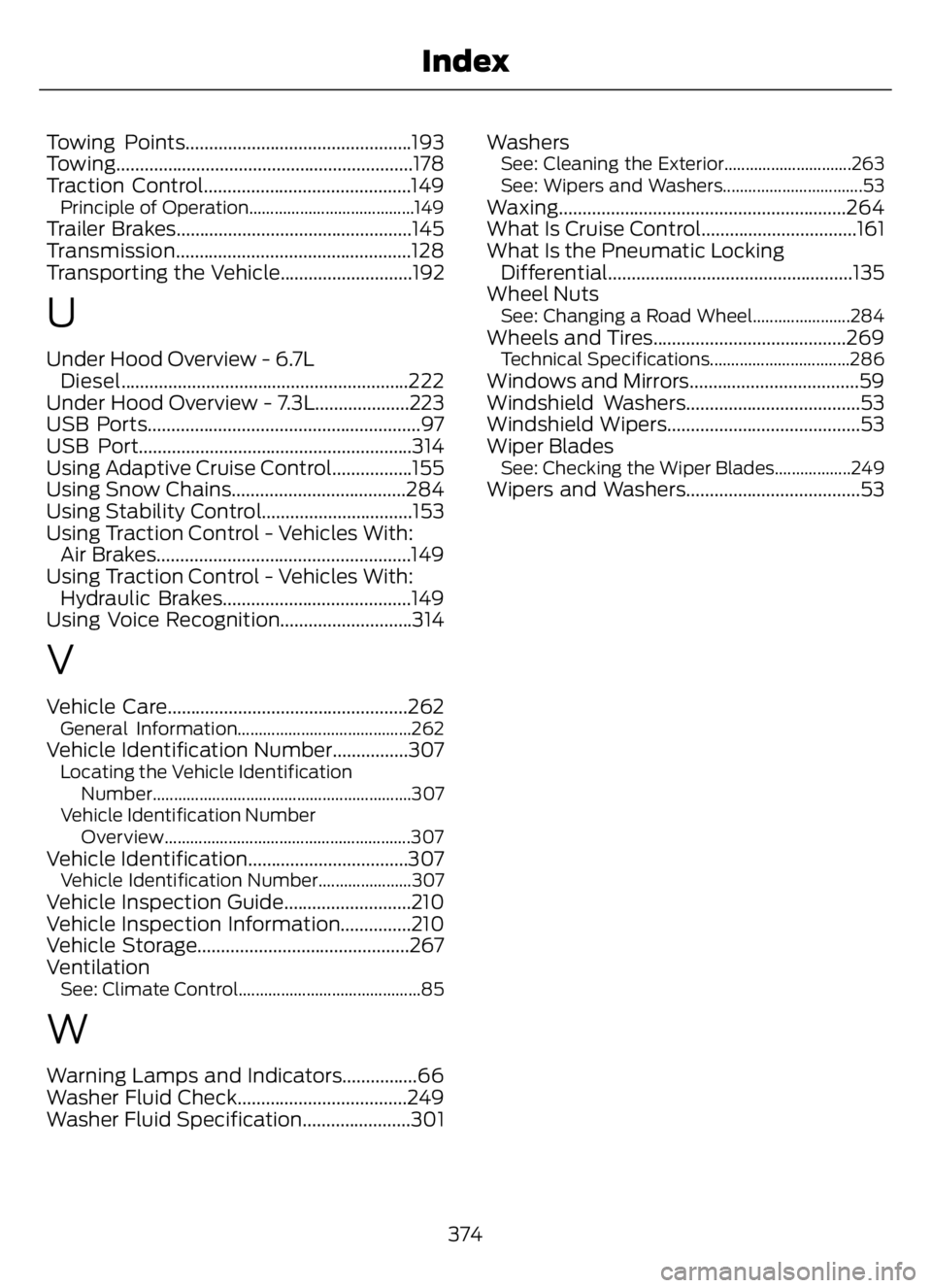
Towing Points................................................193
Towing...............................................................178
Traction Control............................................149
Principle of Operation.......................................149Trailer Brakes..................................................145
Transmission..................................................128
Transporting the Vehicle............................192
U
Under Hood Overview - 6.7L
Diesel.............................................................222
Under Hood Overview - 7.3L....................223
USB Ports..........................................................97
USB Port..........................................................314
Using Adaptive Cruise Control.................155
Using Snow Chains.....................................284
Using Stability Control................................153
Using Traction Control - Vehicles With:
Air Brakes......................................................149
Using Traction Control - Vehicles With:
Hydraulic Brakes........................................149
Using Voice Recognition............................314
V
Vehicle Care...................................................262General Information.........................................262Vehicle Identification Number................307Locating the Vehicle Identification
Number.............................................................307
Vehicle Identification Number
Overview..........................................................307
Vehicle Identification..................................307Vehicle Identification Number......................307Vehicle Inspection Guide...........................210
Vehicle Inspection Information...............210
Vehicle Storage.............................................267
Ventilation
See: Climate Control...........................................85
W
Warning Lamps and Indicators................66
Washer Fluid Check....................................249
Washer Fluid Specification.......................301Washers
See: Cleaning the Exterior..............................263
See: Wipers and Washers.................................53
Waxing.............................................................264
What Is Cruise Control.................................161
What Is the Pneumatic Locking
Differential....................................................135
Wheel Nuts
See: Changing a Road Wheel.......................284Wheels and Tires.........................................269Technical Specifications.................................286Windows and Mirrors....................................59
Windshield Washers.....................................53
Windshield Wipers.........................................53
Wiper Blades
See: Checking the Wiper Blades..................249Wipers and Washers.....................................53
374
Index